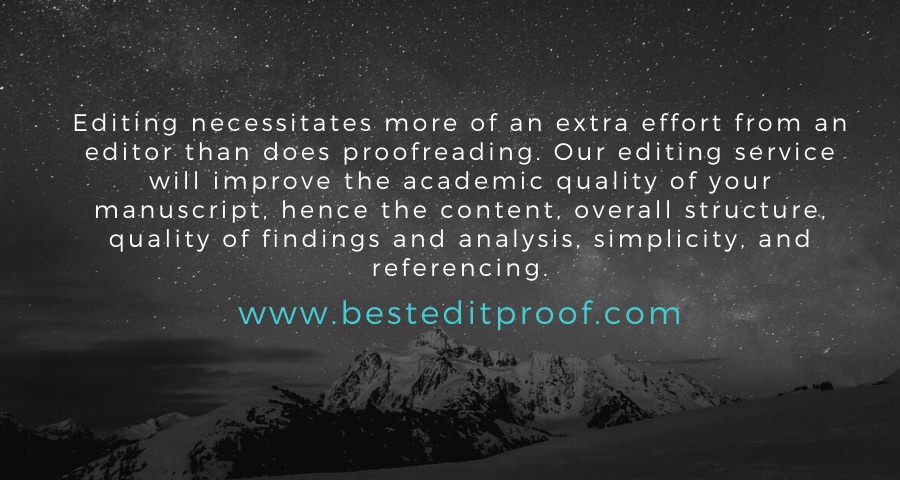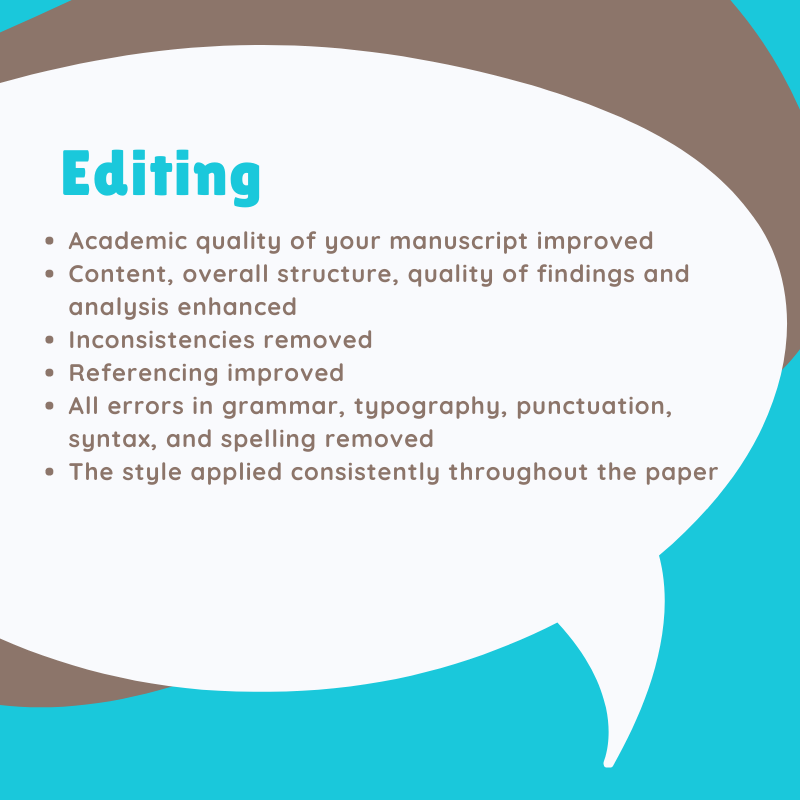The Best Edit & Proof team has created this guide that describes the difference between editing and proofreading, not only to help our customers but for researchers as well as undergraduate and graduate students. On the basis of our experience as a company providing professional editing and proofreading services, we also provide general recommendations as to when a typical client should receive editing or proofreading service.

Many first-time Best Edit & Proof clients are unsure about the difference between proofreading and editing services, and about which service they should choose. Besides, most students and researchers do not fully comprehend the main difference between proofreading and editing services.
The Best Edit & Proof editors have created this guide that describes the main differences between editing and proofreading services, not only to help our customers but for researchers as well as undergraduate and graduate students. On the basis of our experience as a company providing professional editing and proofreading services, we also provide general recommendations as to when a typical client should receive editing or proofreading service.
Although many students and researchers use the terms interchangeably, editing and proofreading services are two different stages of the revision process. Both services require close and careful reading, but they use different methods and center on different aspects of the writing and produce different outcomes for writers.
Editing involves a proactive editor making revisions and suggestions that generally improve your manuscript, particularly in relation to language use and expression. After editing, your language will be sharper and more consistent, your expression clearer, and the overall readability of your writing enhanced. Editing services require more effort from an editor than do proofreading services. Editing improves the academic quality of your writing, hence the content, overall structure, quality of findings and analysis, simplicity, and referencing.
An experienced doctorally qualified editor will mostly make some fundamental changes to improve the standard of the academic writing of the manuscript. Accordingly, an editor will sometimes re-write some parts of the document. This is especially important because an editing service aims to guarantee that the purposes of the document are properly stated.

The purpose of the editing service is to ensure that a manuscript is error-free. Therefore, a qualified editor will correct all errors in grammar, typography, punctuation, syntax, and spelling in a document. In this sense, the editing service involves the proofreading of your manuscript with spelling, grammatical, and other language errors eliminated. One of the most important missions of editing is to ensure that your writing gives the impression that the English language comes naturally to you, even if it does not.
An editor edits a manuscript on consideration of several factors, such as overall structure, formatting, clarity, style, content, and citations.
An editing service checks whether your manuscript has an appropriate introduction and conclusion. The introduction is the first part of your academic essay, and this is where the introductory aspect of the major subject comes in.
This is a crucial part because it is where you give your first impression; thus, it should pique the curiosity of your readers. Moreover, the introduction is the big picture of your academic essay. It is also considered the face or door of your manuscript that indicates your objectives; therefore, it should be persuasive enough to attract your readers’ attention.
An editing service checks the following points of the introduction of the manuscript:
Does the introduction have a good attention getter?
Does it have attention-grabbing sentences to capture the attention of the audience, emphasizing issues from general to specific?
Does this part give a piece of the general information on the major subject?
Is the author’s argument clearly discussed and specified in the introduction of the article or thesis?
Does the introduction pose the question(s) or problem(s) the manuscript aims to answer?
Is the problem statement of the manuscript clearly defined and described in the introduction?
Is it clear how each paragraph in the body of the manuscript is connected to the author’s argument? Are these paragraphs arranged in a logical sequence? Has the author made clear transitions between paragraphs?
A well-structured manuscript helps authors to systematize their views clearly by implementing and substantiating their arguments. Thus, writers need to organize their ideas in advance according to a specific scheme if they wish to have a successful manuscript. With the aid of a plan, authors have a valuable opportunity to make the process of academic essay writing easier. (For more information about academic writing, read the following blog: ‘‘Best Ways to Improve Academic Essay Writing’’). An editor also checks the format of the manuscript since attractive and consistent formatting is essential for making a good first impression on your readers.
Editing services check the content of the manuscript by reviewing the following points:
Has the author done everything the assignment requires?
Are all of the author’s claims accurate and consistent?
Does the manuscript make a logical and complete argument?
Is each of the author’s points supported by adequate evidence?
Are all the information and arguments in the manuscript relevant to the assignment and/or the author’s overall writing goal?

Editing services check the clarity and style of academic essays. An editor’s objective is to determine whether or not there is a lack of clarity in the documents.
Is the meaning of each sentence clearly expressed?
Has the author defined any important terms that might be unclear to their audience?
Does the author show clearly what each pronoun refers to?
Has the author chosen the proper words to express the ideas discussed in the manuscript?
Does the author avoid using words (they find in the thesaurus) that may be inappropriate for any context of their manuscript?
Citations and academic referencing are important because they acknowledge the sources you used in your manuscript. It requires the linking of the citations to the list of works cited in a manuscript and gives credit to the sources of information used in the study. A citation is a technique to give credit to authors for their ideas that you used to support your study. It also allows readers to locate specific sources. Academic referencing tells target readers that this author is not the first one who started the subject. Moreover, it enables authors to show that they are using others’ creative and intellectual works to create a new one. In this way, readers can have the opportunity to track these references to get more ideas about a specific point the author has made.
Are the citations and references in the correct format?
Has the author appropriately cited quotes, paraphrases, and ideas they got from other sources?
Does the author acknowledge the sources they used in their manuscript?
Has the author used the cited material to support their specific thesis statement?
Does the author give the original author credit for the latter’s ideas and work?
Does the manuscript enable the audience to follow up on the original work if they so desire?
Is it clear what citation style the manuscript has?
Does the author link the citations to the list of works cited in a manuscript?
Does the manuscript have full citations listed at the end of the main text?
Does the manuscript follow the rules and standards of citations and references?
Does the manuscript include both in-text citations and a reference list?
Does the manuscript follow a specific style?
Is the style applied consistently throughout the manuscript? (See the Best Edit & Proof’s citation and academic referencing blogs for more information).
Best Edit & Proof expert editors aim to provide your manuscripts with proper scholarly and academic tone and style. They will significantly improve the chances of your having your research manuscript accepted for publishing. They provide subject-area proofreading and editing services in several fields categorized under various disciplines. With our extensive knowledge and expertise, we will help you find the right tone and style for your manuscript.
If you need our subject-area editors to format your manuscripts, giving you the fundamental rules for formatting your manuscripts as described in your guidelines, such as APA, MLA, or Chicago/Turabian styles, then contact us. At Best Edit & Proof, our proofreaders and editors edit every type of academic paper. We have a user-friendly website and a simplified ordering process.
If you would like our subject-area editors and language experts to work on your project for the improvement of its academic tone and style, then please visit the order page. It's easy! It takes only a few minutes to submit your manuscript and to complete the process. Click here to see how it works.
We have flat-rate pricing based on our type of service (editing or proofreading), word count, and turnaround time. Enter your word count or copy and paste your document into our pricing calculator to get an instant quote.
If you need support for editing and proofreading services, contact us. You can also e-mail us or use the 24/7 live chat module to get direct support. We have a 24/7 active live chat mode to offer you direct support along with qualified editors to refine and furbish your manuscript. Alternatively, you can text us through our WhatsApp business line.
Follow us on Twitter, LinkedIn, Facebook, Instagram, and Medium.
For more posts, click here.
This handout discusses the main difference between editing and proofreading services. To give you an opportunity to practice proofreading, we have left a few spelling, punctuation, or grammatical errors in the text. See if you can spot them! If you spot the errors correctly, you will be entitled to a 10% discount.

There is always a misconception regarding editing and proofreading services. Although both services are somehow connected to each other, they still have many differences. Proofreading and editing are two major aspects which are to be focused on in order to successfully complete an academic content file. In this guide, the concepts of proofreading and editing will be cleared accordingly, focusing on the basic differences as well as techniques to accomplish both tasks.
Continue Reading
Proofreaders check the grammatical, punctuation, spelling, and formatting errors of a document and create a proofreading checklist to track the revisions for a flawlessly written academic paper. The type of checklist proofreaders choose to utilize depends on the type of paper (e.g., dissertations, essays, e-books, or blog posts) they are working on.
Continue Reading
No matter what you are working on, be it a commercial project or an academic work — editors and proofreaders are indispensable individuals to your team. While many researchers believe that they can make it without an editor and proofreader, the truth is having someone to check and recheck your work can help elevate the quality of your work by leaps and bounds. There are several reasons why you should let someone edit and proofread your work. But before all that, we will help you understand what an editor and proofreader can help you achieve. This article gives you some basic information so you can understand the roles of editors and proofreaders, along with how they can help you improve your work.
Continue Reading
Proofreading a dissertation differs from dissertation editing in the aspect that it does not drastically change the composition of the manuscript. The fundamental purpose of dissertation proofreading is to enhance a document's linguistic clarity and formatting. And as such, the amount of time required to proofread is lower than that needed to edit a dissertation. It is an integral part of the dissertation submission process that ensures a manuscript's overall veracity. But, owing to its low turnaround time and seemingly lackluster objective, many academics do not prioritize proofreading adequately.
Continue Reading
The benefits of leveraging the services of a dissertation editor are far and wide. They augment the quality of a dissertation by a significant margin, are reliable, and take from scholars the stress of editing. But, when it comes to choosing the right editor(s), the process can prove difficult and complex. Hence, to hire excellent editors for their purpose(s) without wasting much time, scholars should observe the aforementioned tips meticulously.
Continue Reading